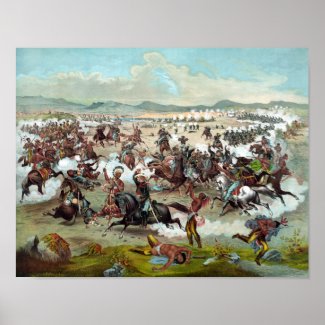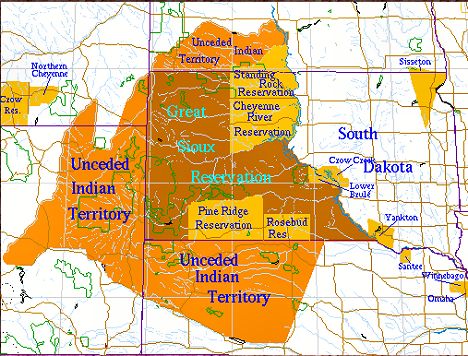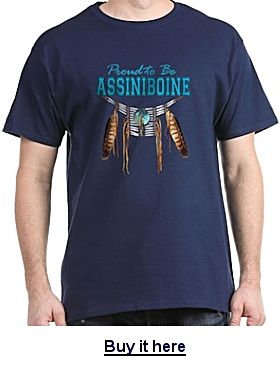Sioux Indian Tribes
The Sioux Nation is a large and powerful tribe of Indians, who were found by the French, in 1640, near the headwaters of the Mississippi River. They occupied the vast domain extending from the Arkansas River, in the south, to the western tributary of Lake Winnipeg, in the north, and westward to the eastern slopes of the Rocky Mountains.
The Sioux have been classed into four grand divisions – namely, the Winnebagoes, who inhabited the country between Lake Michigan and the Mississippi, among the Algonquians; the Assiniboines, or Sioux proper (the most northerly of the nation) ; the Minnetaree group, in Minnesota; and the Southern Sioux, who dwelt in the country between the Arkansas and Platte rivers, and whose hunting-grounds extended to the Rocky Mountains.
In 1679 Jean Duluth, a French officer, set up the Gallic standard among them near Lake St. Peter, and the next year he rescued from them Father Hennepin, who first explored the upper Mississippi.
The French took formal possession of the country in 1685, when the Sioux were divided into seven eastern and nine western tribes. In wars with the French and other Indians, they were pushed down the Mississippi, and, driving off the inhabitants of the buffalo plains, took possession.
Others remained on the shores of the St. Peter. Some of them wandered into the plains of Missouri, and there joined the Southern Sioux.
Sioux History
In the War of 1812 the Sioux took sides with the British.
In 1822 the population of the two divisions of the tribe was estimated at nearly 13,000. In 1837 they ceded to the United States all their lands east of the Mississippi, and in 1851 they ceded 35,000,000 acres west of the Mississippi for $3,000,000.
The neglect of the government to carry out all the provisions of the treaties for these cessions caused much bitter feeling, and a series of hostilities by some of the Sioux ensued; but after being defeated by General Harney, in 1855, a treaty of peace was concluded.
Many bands fled into what was then Dakota Territory, and the strength of the nation was greatly reduced. The most guilty bands fled into the British dominions, while others, from time to time, attacked settlements and menaced forts. Loosely made treaties were violated on both sides.
By one of these the Black Hills were made part of a reservation, but gold having been discovered there, the United States wished to purchase the tract, and induce the Indians to abandon that region and emigrate to the Indian Territory. They showed great reluctance to retreat, and to this day, hold and defend their claim to the Black Hills, which are sacred to them.
Sitting Bull, Spotted Tail, and Red Cloud visited the national capital in 1875, but President Grant could not induce them to sign a treaty. Commissioners met an immense number of them at the Red Cloud agency, in September, but nothing was done. The sending of surveyors under a military escort to the Black Hills caused the Sioux to prepare for war.
This conflict was called Red Cloud’s War.
The Battle of Little Big Horn
In the spring of 1876 a military force was sent against the Sioux, and in June a severe battle was fought, in which General Custer and all of his immediate command were slain. This battle will live in infamy, popularly referred to as “The Battle of Little Big Horn”, or “Custer’s Last Stand”.
By whatever name it is called, it will be remembered as one of the most significant victories of the Indian Nations. While in the end their cause was lost, they demonstrated their superb bravery and military skill in defeating Custer and humiliating the US Army.
The Battle of Wounded Knee
On Dec. 15 a body of Indian police, acting under orders from General Miles, attempted to arrest Sitting Bull in his camp, about 40 miles northwest of Fort Yates, North Dakota. A skirmish ensued, and in it the noted chieftain, together with his son Crowfoot and six other Indians, was killed.
The remnant of the band made its way to the Bad Lands for a time and eventually decided to surrender. While camped outside the fort waiting for their fate to be determined, they began a Ghost Dance, which alarmed the solders.
On Dec. 28 a battle occurred near Wounded Knee, South Dakota, between a cavalry regiment and the men of Big Foot’s band. Thirty of the whites were killed, while the Indian dead numbered over 200, including many of their women and children.
Over 3,000 Indians then fled from the agency and encamped near White Clay Creek, where, on the next day, another encounter occurred. The result of this engagement was the dispersal of the Indians with heavy loss, and the death of eight soldiers of the 9th Cavalry.
Several other skirmishes occurred during the week which followed, with loss of life on both sides. On Jan. 14, 1891, two councils were held with General Miles, and the chiefs, seeing the hopelessness of their cause, agreed to surrender their arms and return to the agency.
The war was practically ended, and on Jan. 21 the greater part of the troops were withdrawn from the neighborhood of the reservation. On the 29th, a delegation of Sioux chiefs, under charge of Agent Lewis, arrived in Washington for the purpose of conferring with the Secretary of the Interior. The conference began on Feb. 7, and continued four days, at the close of which the Indians were received by President Harrison at the White House.
They were assured that the cutting down of the congressional appropriation was an accident, and that the government desired faithfully to carry out every agreement made. On their return home the chiefs stopped for a short time at Carlisle, Pa., where the children of several of them were attending school.
In 1899 the total number of Sioux was 27,215, divided into nineteen bands, and located principally in South Dakota.
Remember the Dakota 38 Wašíčuŋ Tȟašúŋke or American Horse, the Younger
Assiniboin Tribe
Tribal Origin: Siouan FamilyAlso known as: Asiniibwaan, means ‘Stone Sioux’Native Name: Hohe NakotaHome Territories: Northern Great Plains of America and CanadaLanguage: LakotaAlliances: CreeEnemies: Atsina and Blackfeet
Brule Sioux
Tribal Origin: Siouan FamilyNative Name: Sichanghu, means ‘burnt thighs’Home Territories: The DakotasEnemies: Arikara
Dakota Sioux
Tribal Origin: Siouan FamilyAlso known as: Eastern SiouxNative Name: Dakota, means ‘Allies’ or ‘Friends’Home Territories: Dakotas, Minnesota, Nebraska, South Carolina, Manitoba and southern SaskatchewanLanguage: LakotaAlliances: Sioux Nation
Hunkpapa Sioux
Tribal Origin: Siouan Family (Lakota)Native Name: Hunkpapa, means ‘gatekeepers’Home Territories: North Dakota and South DakotaEnemies: All nearby tribes and Whites
Mdewakanton Sioux
Tribal Origin: Siouan Family (Insanti Dakota)Also known as: GattackaNative Name: Na-ishañ-dina, means ‘our people’Home Territories: NebraskaLanguage: mde wakan
Oglala Sioux
Tribal Origin: Siouan Family (Lakota)Native Name: Oglala, means ‘to scatter one’s own’Home Territories: Nebraska, South Dakota and WyomingLanguage: LakotaAlliances: CheyenneEnemies: All other surrounding tribes
Santee Sioux
Tribal Origin: Siouan family (Dakota)Also known as: Ati, means ‘to pitch tents at’Native Name: Isañyati, means ‘knife’Home Territories: NebraskaLanguage: Dakota
Teton Sioux
Tribal Origin: SiouxAlso known as: LakotaNative Name: Titonwan, means ‘dwellers on the prairie’Home Territories: Nebraska, North Dakota and South DakotaLanguage: Lakota
Modern Day Sioux Tribes:
Assiniboine and Sioux Tribes of the Fort Peck Indian Reservation (F)
Cheyenne River Sioux Tribe (F)
Crow Creek Sioux Tribe of the Crow Creek Reservation(South Dakota) (F)
Flandreau Santee Sioux Tribe of South Dakota (F)
Fort Belknap Indian Community of the Fort Belknap Reservation of Montana (F)
Lower Brule Sioux Tribe of the Lower Brule Reservation (F)
Lower Sioux Indian Community in the State of Minnesota (F)
Oglala Sioux Tribe (F)
Prairie Island Indian Community in the State of Minnesota (F)
Rosebud Sioux Tribe of the Rosebud Reservation (F)
Santee Sioux Nation (F)
Shakopee Mdewakanton Sioux Community of Minnesota (F)
Sisseton-Wahpeton Oyate of the Lake Traverse Reservation, South Dakota (F)
Spirit Lake Tribe (F)
Standing Rock Sioux Tribe of North & South Dakota (F)
Upper Sioux Community (F)
Yankton Sioux Tribe (F)
Sioux People of Note
Famous Assiniboine



